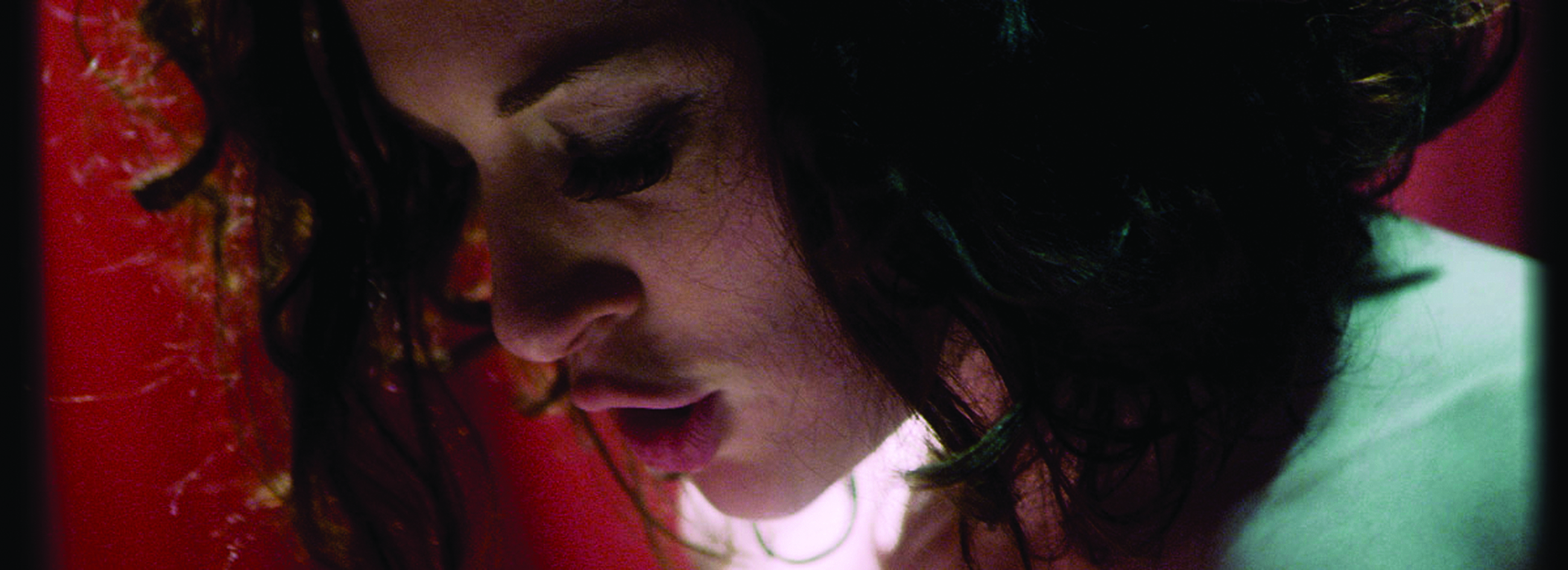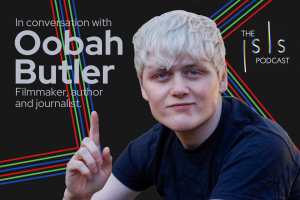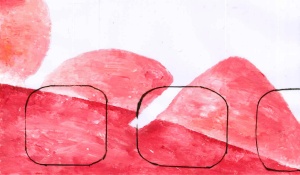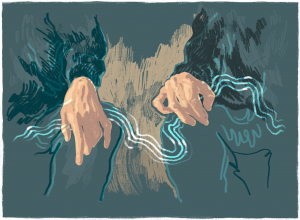
Porn from the Inside: In conversation with Stoya
by James Waddell | February 28, 2015
For some, the word “pornstar” now reeks of ‘70s tack, evoking fake tan, muzak and pizza delivery boys turning up at Californian poolsides. Everything, from the colours to the body parts, is enhanced to the point of hyperreality. Stoya is a pornstar. But she is a pornstar unlike any other. Even in the first moments of our conversation over Skype, it was clear that her darkly striking good looks belonged more in autumnal Brooklyn than in the Golden State. Her website bio confirms: “After a brief stint in Hollywood, California, Stoya moved back to east coast skyscrapers, preferring the brash, concrete reality of the east to the 24/7 sand and glam of the west coast.” Her body has the wiry power of someone who “took a lot of dance lessons”, and bucking the LA trend, she has kept it that way, turning down the offer of free breast implants from her employers – twice.
The porn she makes is unconventional too, with conspicuous delight and ebullient giggling replacing sultry moaning, to the extent that one early partner, Mick Blue, initially thought he was being made fun of. Although she is the first to point out that “I’m Caucasian, I’m symmetrical, I meet the Western cultural standard for ‘attractive’, or at least one of them”, she has defied much of what the porn industry had decided was sexually attractive in women – and then became one of the most successful pornstars of the decade.
But the differences with the buxom bimbo stereotype go far beyond appearances. As well as acting in adult films, Stoya is a writer for Vice, the New Statesman, The Guardian, and The New York Times, writing with frankness and lucidity about sex, the porn industry, art, and where the lines between them are drawn.
From the outset, Stoya vehemently distances herself from the “societal narrative” that porn is something you “fall into”: “I came from a middle-class background, my mum was a second-wave-ish feminist in that politically charged ‘70s era, and I was steeped in that. I absolutely made a choice. I almost skipped into it. I was like: ‘Porn! Wait, I get to pick who I have sex with? Okay, sounds like fun! What do I want to want to do with my life later? Do I want to be a politician, no; do I want to work with young children, no; okay pretty much no horrible ramifications, let’s go!’” She did, and she was almost instantly an unprecedented success. At a time when “alt-girl” stars like Sasha Grey were in their heyday, demand was high, and her rise to fame was meteoric. Within two years of trademarking the name “Stoya”, she had not only won the Adult Video News “Best New Starlet” Award, but had lent her name to a silicon sex toy moulded from her own vagina (the “Stoya Destroya” Fleshlight).
At least some of her phenomenal popularity was down to her striking authenticity, or at least her talent for naturalism – not a quality that had been characteristic of much mainstream porn up to that point. When new acquaintances – and journalists – tell her that they want to meet ‘the real Stoya’, she tells them that if they’ve seen her work, they already have. “I don’t have sex with people on camera who I wouldn’t have sex with anyway… The thought process is: would I do this? Yes. So let’s do this on camera.” Is there a ‘Stoya’ persona at all? “Acting – speaking as someone who doesn’t know anything about acting – seems to have this connotation of becoming a different person and inhabiting a role. I come from much more of a live performance perspective; I took a lot of dance lessons and still perform as a dancer, and that’s how I approach my work too. So, I am really doing these things as me, but it’s naturally going to be turned up a few notches, not because I take the ‘me’ hat off and put the ‘Stoya’ hat on, but simply because the level of observation is higher and I’m just aware of that”.
But, eventually, deflecting porn stereotypes had to work both ways. As she carved out a niche as “not your average pornstar”, the persona of the dark-haired, pale-skinned intellectual began to grate too: “I feel the need to mention that academic language and complex theory is not a language that I have gone to the land of college and become fluent in. I can understand it, of course, in the same way that a person who’s got a year of Japanese under their belt would be able to understand Japanese, but I can’t create in terms of that academic language. So when it comes to my work being ‘political’, I think that has to have a lot to do with intent, and my intent when I started performing was just: ‘woo, fun!’”
Despite this, she talks about porn with connoisseurial enthusiasm, dissecting its trends, fads and modes. Is porn like art, then? “First, we have to stop talking about porn as if it’s all one thing. I use this comparison a lot when people talk about “sex work”: “food work” would be an absurd phrase to use to describe everyone from Gordon Ramsay, to the migrant workers who do the picking of the vegetables, to the waiter, to the person washing dishes in the back, and the guy doing the restaurant’s marketing. So in a similar way, porn covers the same spectrum that you get between Hollywood and independent films – you have this broad range. You have different companies that have built up different audiences and cater to those audiences. I mean, until recent history most pornography was, even at its biggest, made by small companies that had maybe 40 employees in a small office, and it’s only in the past few years with the rise of companies like Manwin, who have been buying up all these smaller filmmakers that we’re actually getting ‘Big Porn’. But anyway, compared to those companies that had 40 employees, that were the more mainstream, established companies, you had independent studios, where it’s stuff like Shine Louise Houston’s Pink and White where they do the Crashpad series, or Courtney Trouble’s ‘Indie Porn’ revolution, which are very much artworks. So to answer your question, I think that there’s lots of different things called porn, some of them have more qualities that we would associate with art than others.”
Either way, “ultimately, porn is also at its root very commercially driven in a way that art is maybe less so.” Even if Stoya loves her job, it’s still just a job: “We call sex work ‘selling your body’, but then we don’t call it selling your body when you’re working in construction, even though you’re very clearly being paid for the use of your body for a certain period of time, for a certain task. In construction there’s a significant amount of physical wear and tear that’s happening to your body. So I would say actually, if we’re gonna put the label of ‘selling your body’ on one or the other, I would go with the construction industry”.
After the 50 Shades of Gray revolution (“I downloaded all three books, and stuck it out to the bitter end…the saddest and worst fairytale ever”), the dangers of “physical wear and tear” from BDSM sex do not just apply to sex workers, but to an ever-wider population, a trend that Stoya is wary of: “If you suddenly turn up in the bedroom with a crop and you’re suddenly flailing someone willy-nilly, you can seriously damage their internal organs! You can do major physical damage, but also if you think you’re sorted by just saying that ‘bicycle’ is your safe-word and holding that up as the one thing that makes things safe, and there aren’t conversations and getting to know each other first, that navigation of boundaries then enables the people that you’re engaging in these activities with to think ‘oh, you didn’t say bicycle. It’s because you’ve gone deep into emotional-trauma-land for some reason so, ya can’t, and someone needs to call a stop to this.’ So it’s both physically and emotionally very dangerous when it’s approached in this superficial way.”
Surely, I ask, when even Stoya’s more “naturalistic” brand of porn still shows, through directorial sleight of hand, feats of sexual performance that are not only impossible but potentially dangerous (anal sex requires more than the thirty seconds of foreplay that are shown, for example), isn’t that risky miseducation too? For the first time, Stoya seems uncomfortable: “I argued for a very long time that porn is entertainment and should not be used as a guide to having sex. But, it’s true, I have finally come to the realisation, that sex education is so fucking shit all over the entire western hemisphere and definitely beyond that, that entertainment is the only thing that people are getting rational sex education from. And so while I do maintain that it is not porn’s job to provide context, at the same time, until certain governments or educational institutions want to step the fuck up and provide some context, the people who are willing or able to do so coming from entertainment and sex work kind of have to… This is a big cultural problem that shouldn’t be in porn’s lap. But the fact is, it kind of is, so what can I do? But it still shouldn’t be entertainment’s problem!”
This is a complex stance taken over a complex problem – legislating for and taking action within an industry as thornily multivalent as Stoya’s can often entail such seemingly paradoxical standpoints. But Stoya doesn’t shy away from contradictions. She is sex worker and thinker, sex symbol and feminist, anti-academic and writer. Despite these paradoxes, one thing she certainly is – is about as far from the ‘70s “pornstar” kitsch that initially leaps to mind as it’s possible to get. As the interview comes to a close and we chatter about social media, she is the epitome of the millennial generation. Acutely sensitive to cultural zeitgeist, cannily aware of personal brand, and fiercely independent – in every sense.
Image used with permission from Stoya




